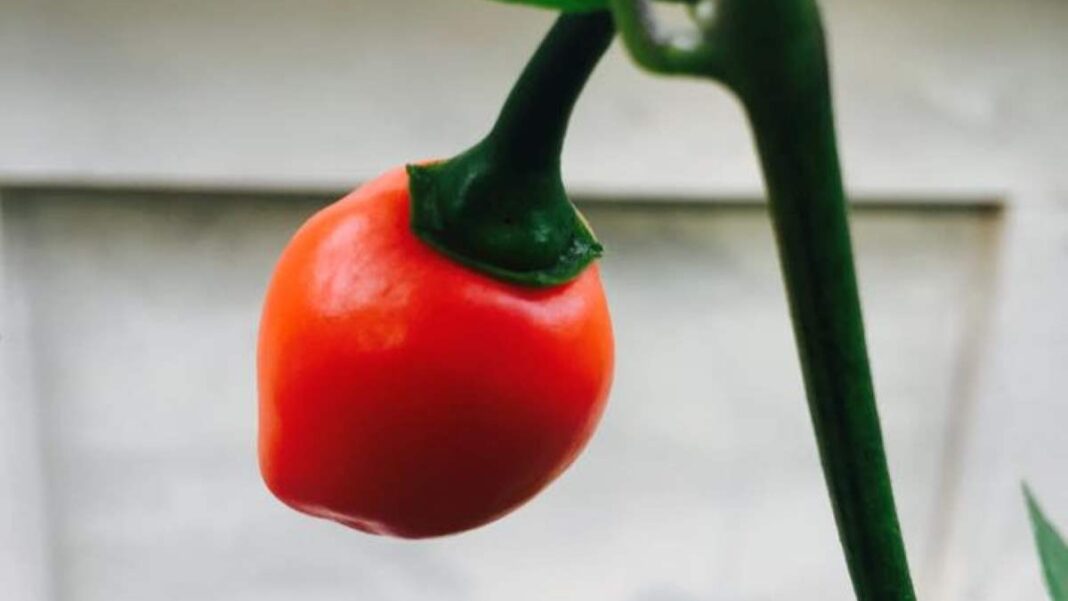- Akabare Khursani, also known as Dalle Khursani, is grown in Nepal’s eastern hills.
- Its heat ranges between 100,000 and 350,000 SHU—comparable to habanero chilies.
- The pepper is prized for its bright red color, fruity aroma, and rich cultural heritage.
- It’s widely used in pickles, chutneys, spice blends, and traditional meals like dal bhat.
- Locals value it for its potential health benefits, including aiding digestion and fighting infection.
Rooted in the Hills, Revered Worldwide
Small, round, and unapologetically spicy—Akabare Khursani has long been a source of culinary pride across the Himalayas. Native to Nepal, and cultivated in Bhutan, Sikkim, and parts of West Bengal, this pepper has earned legendary status in Nepali kitchens. Known for its explosive heat and tangy aroma, it’s far more than a food item—it’s a symbol of heritage and identity.

Grown Where the Air Is Thin and the Soil Is Rich
Akabare thrives best in the high-altitude districts of eastern Nepal. Regions like Ilam, Taplejung, and Panchthar are especially renowned for producing premium-quality chilies. The unique combination of cool temperatures, fertile soil, and crisp mountain air in these areas enhances the chili’s signature sharpness and full-bodied aroma—qualities that make it stand out globally.
How Hot Is It?
- Scoville Heat Units (SHU): 100,000 to 350,000, putting it in the same league as the habanero.
- In local markets, milder strains may fall between 8,000 and 30,000 SHU.
- The heat builds gradually and settles in the throat—often described as sharp and focused.
- Interestingly, the burn tends to fade quickly, without the lingering sting some chilies are known for.
What Makes Akabare So Distinct?
- Color: Bright red and glossy when fully ripe
- Aroma: Rich, fruity, and unmistakably pungent
- Capsaicin Content: Exceptionally high—explains the intense spiciness
- Altitude Grown: Cultivated at 1,000–2,000 meters above sea level
- Versatility: Used in pickles, stews, curries, and spice powders
Everyday Uses in Nepali Cuisine
From bustling street vendors to quiet village homes, Akabare is everywhere. It’s crushed into fiery chutneys, mixed into meat dishes, or simply served raw alongside a plate of dal bhat (rice and lentils). When pickled—either solo or with fermented bamboo shoots (tama)—it becomes a pantry staple. Many households also dry it under the sun and grind it into a powdered spice blend used year-round.

Is It Good for Your Health?
In traditional medicine and folklore, Akabare Khursani is believed to support metabolism, aid digestion, and protect the immune system. Its rich antioxidant content helps combat inflammation and oxidative stress. Some Nepali households also consider it a folk remedy for gastric discomfort—though this specific claim remains unproven by modern clinical studies.
A Botanical Rarity
Scientifically speaking, Akabare is extraordinary. It’s the only known polyploidal variety of chili pepper, meaning it contains multiple sets of chromosomes. In optimal conditions, plants can reach up to 130 cm in open fields—and even taller in greenhouses. Its nutritional profile is just as impressive. A 100g serving delivers:
- Vitamin C: 240 mg (five times more than an orange)
- Vitamin A: 11,000 IU
- Vitamin E: 0.7 mg
Recognized and Protected
In 2020, the Indian government officially granted the chili a Geographical Indication (GI) tag for Sikkim-grown Dalle Khursani. The tag has since been extended to Darjeeling and Kalimpong. This recognition protects its legacy, helps farmers, and promotes exports to regions where the Nepali diaspora keeps the demand alive.
A Symbol of Home for Millions
Beyond taste, this chili carries emotion. For many Nepali families—especially those living abroad—Akabare Khursani represents home. It’s often packed into suitcases, mailed in care packages, and gifted during weddings or festivals. Its presence on the dining table connects generations, linking the present to a spicy, flavorful past.
Follow Virginia Times for regular news updates. Stay informed with the latest headlines, breaking stories, and in-depth reporting from around the world.
A global media for the latest news, entertainment, music fashion, and more.















